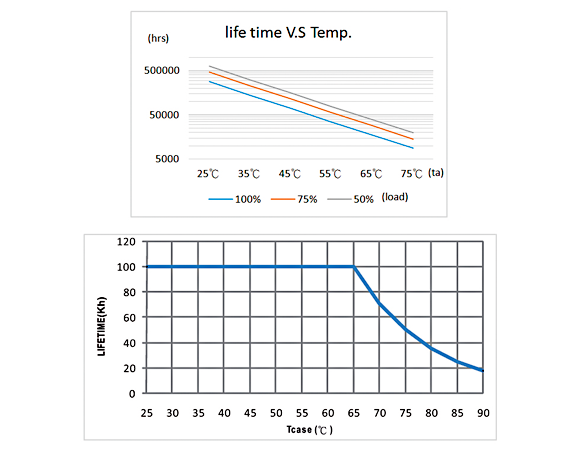|
What counts when choosing a switching power supply? Schukat analyses selection criteria for making the right power-supply choiceWhen selecting a suitable power supply, a number of criteria need to be taken into account. Which factors play the biggest role?1. Probability of malfunction
To achieve the long operational life and high reliability of a switching power supply, the manufacturer, in addition to choosing high-quality components, also has to put the finished power supply through comprehensive electrical, thermal and mechanical stress tests. At the end of the day, critical components like fans and electrolytic capacitors determine the operating life.
Stability and reliability are defined by the MTBF (Mean Time Between Failures). This value eliminates early failures and age-related malfunctions and is calculated from the reciprocal of the addition of all failure rates of the individual components installed. In this way, the reliability of different products or systems can be compared. Complex power supplies often have a lower MTBF than those with simpler topologies.
► Note: When making a comparison, make sure that the identical standard is used to calculate the MTBF. The calculations behind individual standards such as Bellcore/Telcordia, MIL-HDBK-217 and others do differ, and can lead to significantly different results. 2. The role of e-caps
Electrolytic capacitors (e-caps) provide high dielectric strength and high capacitance, are compact and, for economic reasons alone, are irreplaceable. The expected operational life of the aluminium e-caps used in switching power supplies depends on the operating conditions, including load, ripple currents and temperature. Capacitance decreases with the operating time, while the dissipation factor (tanδ) increases (diffusion effect).
Among the factors that ultimately influence the operational life of the capacitors, temperature is the key limiting component..
► Rule of thumb: If the ambient temperature increase by 10°K, the operational lifetime is halved. Conversely, if the temperature drops by 10°K, the operational life can double.
Despite the disadvantageous characteristics, however, a very long operating time of 100,000+ hours can be achieved even with aluminium electrolytic capacitors, given good power-supply design, the use of high-quality components, and attention to thermal management during installation.  | | Example: Expected operational lifetime of an aluminium e-cap as a function of ambient temperature and load (above), and expected operational lifetime of MEAN WELL's XLG-200 power supply series as a function of case temperature (below). |
|
3. Efficiency and thermal conduction
A power supply's efficiency is determined by the ratio of total output power to input power. Since it is impossible to achieve 100 percent efficiency, power loss is inevitable. This loss is dissipated in the warming of the installed passive and active components. With suitable electrical and thermal design and good component selection, it is possible to achieve efficiency well in excess of 90%. Still, residual heat remains, and this needs to be dissipated.
The methods used to dissipate heat vary depending on the application. These methods must be compared in terms of their advantages and disadvantages and adapted to the application.
► Common methods (differing heat dissipation capabilities): natural convection, forced convection, contact cooling and water cooling.
► If natural convection or contact cooling is not sufficient, integrated fans or external fans for forced convection are used.
Downsides: noise caused by fan rotation or airflow, vibration, additional power consumption, dust build-up, and unexpected malfunctions or limited service life.
Fans with dual ball bearings or magnetic bearings promise a significantly longer operational lifetime.
|
|
|














